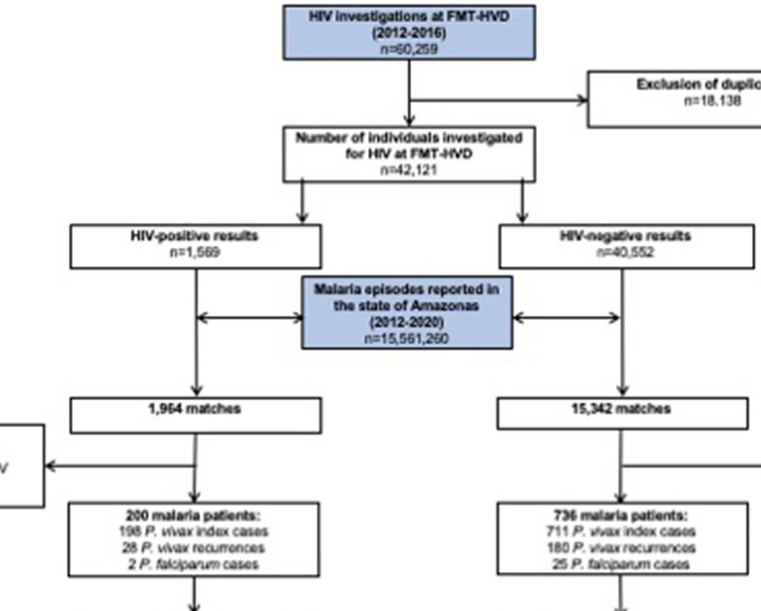HIV infection increases the risk of acquiring Plasmodium vivax malaria: a 4-year cohort study in the Brazilian Amazon HIV and risk of vivax malaria
Globally, malaria and human immunodeficiency virus (HIV) are both independently associated with a massive burden of disease and death. While their co-infection has been well studied for Plasmodium falciparum, scarce data exist regarding the association of P. vivax and HIV. In this cohort study, we assessed the effect of HIV on the risk of vivax malaria infection and recurrence during a 4-year follow-up period in an endemic area of the Brazilian Amazon. For the purpose of this study, we obtained clinical information from January 2012 to December 2016 from two databases. HIV screening data were acquired from the clinical information system at the tropical hospital Fundação de Medicina Tropical Dr. Heitor Vieira Dourado (FMT-HVD). The National Malaria Surveillance database (SIVEP malaria) was utilized to identify malaria infections during a 4-year follow-up period after diagnosis of HIV. Both datasets were combined via data linkage. Between 2012 and 2016, a total of 42,121 people were screened for HIV, with 1569 testing positive (3.7%). Out of all the patients diagnosed with HIV, 198 had at least one episode of P. vivax malaria in the follow-up. In the HIV-negative group, 711 participants had at least one P. vivax malaria episode. When comparing both groups, HIV patients had a 6.48 [(5.37–7.83); P < 0.0001] (adjusted relative risk) greater chance of acquiring P. vivax malaria. Moreover, being of the male gender [ARR = 1.41 (1.17–1.71); P < 0.0001], Amerindian ethnicity [ARR = 2.77 (1.46–5.28); P < 0.0001], and a resident in a municipality of the Metropolitan region of Manaus [ARR = 1.48 (1.02–2.15); P = 0.038] were independent risk factors associated with an increased risk of clinical malaria. Education ≥ 8 years [ARR = 0.41 (0.26–0.64); P < 0.0001] and living in the urban area [ARR = 0.44 (0.24–0.80); P = 0.007] were associated to a lower risk of P. vivax malaria. A total of 28 (14.1%) and 180 (25.3%) recurrences (at least a second clinical malaria episode) were reported in the HIV-positive and HIV-negative groups, respectively. After adjusting for sex and education, HIV-positive status was associated with a tendency towards protection from P. vivax malaria recurrences [ARR = 0.55 (0.27–1.10); P = 0.090]. HIV status was not associated with hospitalizations due to P. vivax malaria. CD4 + counts and viral load were not associated with recurrences of P. vivax malaria. No significant differences were found in the distribution of parasitemia between HIV-negative and HIV-positive P. vivax malaria patients. Our results suggest that HIV-positive status is a risk factor for vivax malaria infection, which represents an additional challenge that should be addressed during elimination efforts.
Authors
Guerra, Cecilia Victoria Caraballo; da Silva, Bernardo Maia; Mi¼ller, Pia; Baia-da-Silva, Djane Clarys; Moura, Marco Antonio Saboia; Araiuo, Jose Deney Alves; Silva-Neto, Alexandre Vilhena; da Silva Balieiro, Antonio Alcirley; da Costa-Martins, Andre Guilherme; Melo, Gisely Cardoso;
External link
Publication Year
Publication Journal
Associeted Project
Digital Epidemiology
Lista de serviços
-
Gene regulatory and signaling networks exhibit distinct topological distributions of motifs.Gene regulatory and signaling networks exhibit distinct topological distributions of motifs.
-
Gene signatures of autopsy lungs from obese patients with COVID-19.Gene signatures of autopsy lungs from obese patients with COVID-19.
-
Network Medicine: Methods and ApplicationsNetwork Medicine: Methods and Applications
-
ACE2 Expression Is Increased in the Lungs of Patients With Comorbidities Associated With Severe COVID-19.ACE2 Expression Is Increased in the Lungs of Patients With Comorbidities Associated With Severe COVID-19.
-
Drug repositioning for psychiatric and neurological disorders through a network medicine approach.Drug repositioning for psychiatric and neurological disorders through a network medicine approach.
-
Linking proteomic alterations in schizophrenia hippocampus to NMDAr hypofunction in human neurons and oligodendrocytes.Linking proteomic alterations in schizophrenia hippocampus to NMDAr hypofunction in human neurons and oligodendrocytes.
-
In-depth analysis of laboratory parameters reveals the interplay between sex, age, and systemic inflammation in individuals with COVID-19.In-depth analysis of laboratory parameters reveals the interplay between sex, age, and systemic inflammation in individuals with COVID-19.
-
The evolution of knowledge on genes associated with human diseasesThe evolution of knowledge on genes associated with human diseases
-
Network vaccinology.Network vaccinology.
-
Pyruvate kinase M2 mediates IL-17 signaling in keratinocytes driving psoriatic skin inflammationPyruvate kinase M2 mediates IL-17 signaling in keratinocytes driving psoriatic skin inflammation
-
Transcriptome analysis of six tissues obtained post-mortem from sepsis patientsTranscriptome analysis of six tissues obtained post-mortem from sepsis patients
-
Gene Signatures of Symptomatic and Asymptomatic Clinical-Immunological Profiles of Human Infection by Leishmania (L.) chagasi in Amazonian BrazilGene Signatures of Symptomatic and Asymptomatic Clinical-Immunological Profiles of Human Infection by Leishmania (L.) chagasi in Amazonian Brazil
-
In vitro morphological profiling of T cells predicts clinical response to natalizumab therapy in patients with multiple sclerosis.In vitro morphological profiling of T cells predicts clinical response to natalizumab therapy in patients with multiple sclerosis.
-
Integrative immunology identified interferome signatures in uveitis and systemic disease-associated uveitis.Integrative immunology identified interferome signatures in uveitis and systemic disease-associated uveitis.
-
Gene regulatory networks analysis for the discovery of prognostic genes in gliomas.Gene regulatory networks analysis for the discovery of prognostic genes in gliomas.
-
Revealing shared molecular drivers of brain metastases from distinct primary tumors.Revealing shared molecular drivers of brain metastases from distinct primary tumors.

